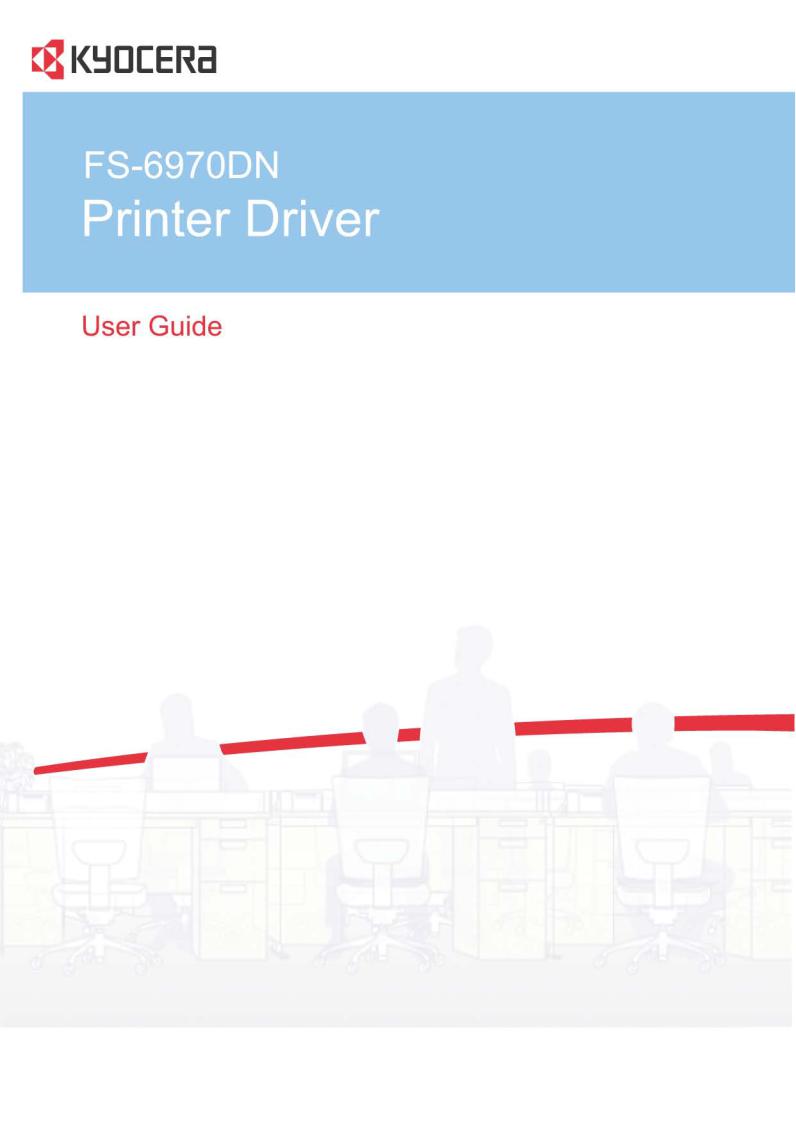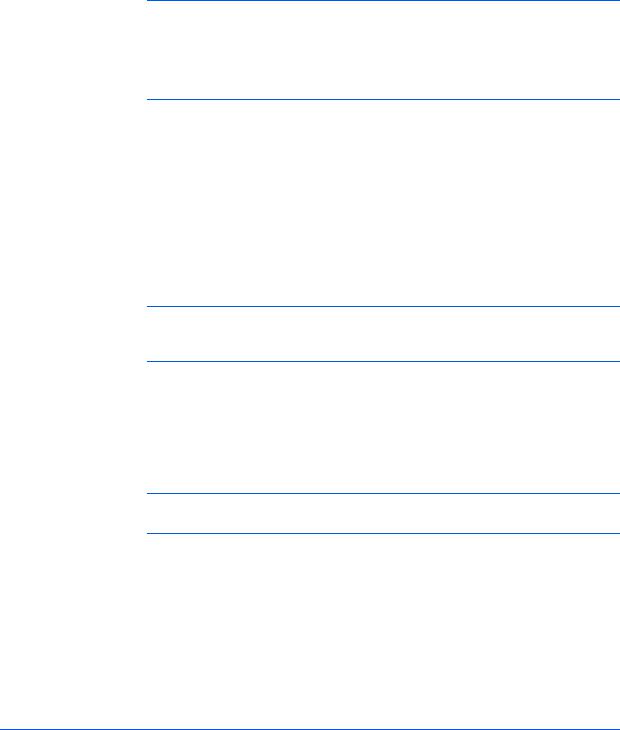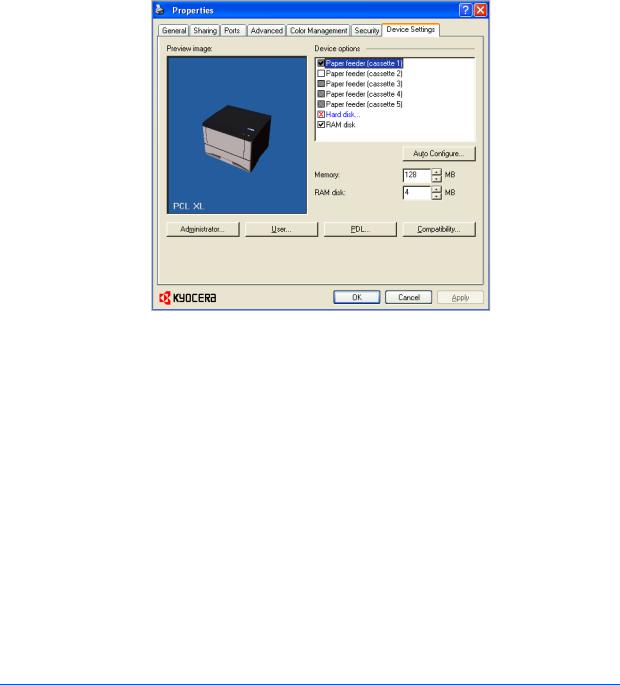Kyocera FS-6970DN User Manual

Legal Notes
Unauthorized reproduction of all or part of this guide is prohibited.
The information in this guide is subject to change for improvement without notice.
We cannot be held liable for any problems arising from the use of this product, regardless of the information herein.
Regarding Trademarks
Microsoft Windows is a registered trademark of Microsoft Corporation in the U.S. and/or other countries. KPDL is a trademark of Kyocera Corporation. PCL is a trademark of Hewlett-Packard Company. TrueType is a registered trademark of Apple Computer, Inc. Adobe, Acrobat, Adobe Reader, Photoshop and PostScript® are trademarks of Adobe Systems, Incorporated.
All other brand and product names herein are registered trademarks or trademarks of their respective companies.
Examples of the operations given in this guide support the Windows XP printing environment. Essentially the same operations are used for Microsoft Windows 7, Windows Vista, Windows Server 2003, Windows Server 2008 and Windows 2000 environments.
User Interface screen captures shown in this guide may differ depending on your printing device.
Model supported by the KX printer driver
FS-6970DN
Copyright © 2010 KYOCERA MITA Corporation
All rights reserved.

Table of Contents
Chapter 1 |
Installation |
|
|
Preparing to Install the Driver ........................................................................................................ |
1-1 |
|
Selecting an Installation Method ................................................................................................... |
1-1 |
|
Installing Utilities ........................................................................................................................... |
1-2 |
|
Upgrading Driver Components ...................................................................................................... |
1-2 |
|
Express Installation ....................................................................................................................... |
1-2 |
|
Installing in Express Mode ....................................................................................................... |
1-2 |
|
Custom Installation ....................................................................................................................... |
1-4 |
|
Installing in Custom Mode with a USB Connection .................................................................. |
1-4 |
|
Installing in Custom Mode with a Network Connection ............................................................ |
1-5 |
|
Installing in Custom Mode with a Parallel Connection ............................................................. |
1-6 |
|
Optional Printer Components ........................................................................................................ |
1-7 |
|
Installing Optional Printer Components ................................................................................... |
1-7 |
|
Adding a Printer Driver Through the Wizard .................................................................................. |
1-8 |
|
Installing a Printer Driver in Windows 7 and Windows Vista .................................................... |
1-8 |
|
Installing a Printer Driver in Windows XP and Windows 2000 ................................................. |
1-8 |
|
Printer Driver Settings Access ....................................................................................................... |
1-9 |
|
Changing the Default Driver Settings ...................................................................................... |
1-9 |
Chapter 2 Device Settings
Accessing the Device Settings Tab |
............................................................................................... 2-1 |
Device Options .............................................................................................................................. |
2-2 |
Setting Device Options ............................................................................................................ |
2-2 |
Setting up Custom Boxes ........................................................................................................ |
2-2 |
Auto Configure .............................................................................................................................. |
2-3 |
Enabling Auto Configuration .................................................................................................... |
2-3 |
Memory ......................................................................................................................................... |
2-3 |
Setting the Memory ................................................................................................................. |
2-4 |
RAM Disk ...................................................................................................................................... |
2-4 |
Setting RAM Disk .................................................................................................................... |
2-4 |
Administrator Settings ................................................................................................................... |
2-4 |
Job Accounting ........................................................................................................................ |
2-5 |
Show Quick Print Tab .............................................................................................................. |
2-6 |
Lock Security Settings ............................................................................................................. |
2-6 |
Administrator Password .......................................................................................................... |
2-6 |
SNMP ...................................................................................................................................... |
2-7 |
User Settings ................................................................................................................................ |
2-8 |
Identification ............................................................................................................................ |
2-8 |
Units ........................................................................................................................................ |
2-9 |
Language Preference .............................................................................................................. |
2-9 |
PDL (Page Description Language) ............................................................................................... |
2-9 |
PDL Options .......................................................................................................................... |
2-10 |
PDF ....................................................................................................................................... |
2-11 |
XPS Driver .................................................................................................................................. |
2-13 |
Compatibility Settings ................................................................................................................. |
2-13 |
Media Source Enumeration ................................................................................................... |
2-13 |
KX DRIVER |
i |

|
Disable Face-Up Reverse Page Order .................................................................................. |
2-14 |
|
Ignore Application Collation ................................................................................................... |
2-14 |
|
Combine Source and Media Type Lists ................................................................................. |
2-14 |
|
Removing a Plug-in ..................................................................................................................... |
2-15 |
Chapter 3 |
Quick Print |
|
|
Quick Print Options ....................................................................................................................... |
3-1 |
|
Specifying Print Options .......................................................................................................... |
3-1 |
|
Collate ..................................................................................................................................... |
3-2 |
|
Duplex Printing ........................................................................................................................ |
3-2 |
|
Multiple Pages per Sheet ........................................................................................................ |
3-3 |
|
Profile Options .............................................................................................................................. |
3-3 |
|
Selecting Profiles ..................................................................................................................... |
3-3 |
|
Saving a Profile ....................................................................................................................... |
3-3 |
|
Editing a Profile ....................................................................................................................... |
3-4 |
|
Deleting a Profile ..................................................................................................................... |
3-4 |
|
Importing a Profile ................................................................................................................... |
3-4 |
|
Exporting a Profile ................................................................................................................... |
3-5 |
Chapter 4 |
Basic |
|
|
Basic Paper Settings ..................................................................................................................... |
4-1 |
|
Source and Media Types .............................................................................................................. |
4-2 |
|
Print Size and Page Size ............................................................................................................... |
4-2 |
|
Creating a Custom Page Size ................................................................................................. |
4-3 |
|
Printing with Custom Size Pages ............................................................................................. |
4-3 |
|
Duplex Printing .............................................................................................................................. |
4-3 |
|
Printing in Duplex Mode .......................................................................................................... |
4-4 |
|
Collate ........................................................................................................................................... |
4-4 |
|
Printing Collated Documents ................................................................................................... |
4-5 |
|
EcoPrint ........................................................................................................................................ |
4-5 |
|
Kyocera Logo ................................................................................................................................ |
4-5 |
|
Displaying Version Information ................................................................................................ |
4-5 |
|
Displaying Plug-in Information ................................................................................................. |
4-5 |
Chapter 5 |
Layout |
|
|
Booklet .......................................................................................................................................... |
5-1 |
|
Printing a Booklet .................................................................................................................... |
5-1 |
|
Multiple Pages per Sheet .............................................................................................................. |
5-2 |
|
Printing Multiple Pages per Sheet ........................................................................................... |
5-2 |
|
Poster ............................................................................................................................................ |
5-2 |
|
Printing a Poster ...................................................................................................................... |
5-3 |
|
Scaling .......................................................................................................................................... |
5-3 |
|
Setting Scaling on the Page .................................................................................................... |
5-3 |
|
Gutter ............................................................................................................................................ |
5-4 |
|
Creating a Gutter ..................................................................................................................... |
5-4 |
Chapter 6 |
Imaging |
|
|
Print Quality and Custom Quality .................................................................................................. |
6-1 |
|
Selecting Print Quality ............................................................................................................. |
6-1 |
|
Selecting EcoPrint ................................................................................................................... |
6-2 |
|
Fonts ............................................................................................................................................. |
6-2 |
|
Font Settings ........................................................................................................................... |
6-2 |
|
Selecting Font Settings ............................................................................................................ |
6-3 |
|
Font Substitution ..................................................................................................................... |
6-3 |
|
Disable Device Fonts ............................................................................................................... |
6-3 |
ii |
User Guide |

|
Graphics ........................................................................................................................................ |
6-4 |
|
Selecting Graphics Settings .................................................................................................... |
6-4 |
|
Pattern Scaling ........................................................................................................................ |
6-4 |
|
Inversion Settings .................................................................................................................... |
6-4 |
|
Optimization Settings .............................................................................................................. |
6-5 |
|
CIE Optimization ..................................................................................................................... |
6-5 |
|
Halftone Screen ....................................................................................................................... |
6-5 |
|
Adjusting Grayscale ...................................................................................................................... |
6-6 |
|
Selecting Text and Graphics Effects ............................................................................................. |
6-7 |
Chapter 7 |
Publishing |
|
|
Cover Mode .................................................................................................................................. |
7-1 |
|
Printing Covers ........................................................................................................................ |
7-1 |
|
Cover Mode Options ................................................................................................................ |
7-2 |
|
Choosing Cover Media ............................................................................................................ |
7-5 |
|
Page Insert .................................................................................................................................... |
7-5 |
|
Printing Page Inserts ............................................................................................................... |
7-5 |
|
Page Insertion Options ............................................................................................................ |
7-6 |
|
Transparency Interleaving ............................................................................................................ |
7-7 |
|
Interleaving Transparencies .................................................................................................... |
7-7 |
Chapter 8 |
Job |
|
|
Job Storage (e-MPS) .................................................................................................................... |
8-1 |
|
Job Storage (e-MPS) options .................................................................................................. |
8-1 |
|
Custom Box .................................................................................................................................. |
8-2 |
|
Storing a Job in a Custom Box ................................................................................................ |
8-2 |
|
Quick Copy ................................................................................................................................... |
8-3 |
|
Printing a Quick Copy Job ....................................................................................................... |
8-3 |
|
Proof and Hold .............................................................................................................................. |
8-3 |
|
Printing a Proof and Hold Job .................................................................................................. |
8-4 |
|
Private Print .................................................................................................................................. |
8-4 |
|
Storing a Private Print Job ....................................................................................................... |
8-4 |
|
Job Storage ................................................................................................................................... |
8-5 |
|
Storing a Job Storage Job ....................................................................................................... |
8-5 |
|
Job Name ...................................................................................................................................... |
8-5 |
|
Don’t Use Application Name .................................................................................................... |
8-5 |
|
Overwrite Job Name ................................................................................................................ |
8-6 |
|
Selecting a Job Name ............................................................................................................. |
8-6 |
Chapter 9 |
Advanced |
|
|
Prologue/Epilogue ......................................................................................................................... |
9-1 |
|
Selecting a Prologue/Epilogue File .......................................................................................... |
9-1 |
|
Editing a Prologue/Epilogue File ............................................................................................. |
9-1 |
|
Deleting a Prologue/Epilogue File ........................................................................................... |
9-2 |
|
Assigning a Prologue/Epilogue File ......................................................................................... |
9-2 |
|
Unassigning a Prologue/Epilogue File ..................................................................................... |
9-2 |
|
Specifying the Insertion Point .................................................................................................. |
9-2 |
|
Watermark .................................................................................................................................... |
9-3 |
|
Adding or Editing a Watermark ................................................................................................ |
9-3 |
|
Selecting Pages for Watermark ............................................................................................... |
9-4 |
|
Security Watermark ...................................................................................................................... |
9-5 |
|
Adding or Editing a Security Watermark .................................................................................. |
9-5 |
|
Adjusting Security Watermark Calibration ............................................................................... |
9-7 |
|
Selecting Pages for Security Watermark ................................................................................. |
9-7 |
|
Locking the Security Watermark Settings ................................................................................ |
9-8 |
KX DRIVER |
iii |

Configuring Status Monitor ............................................................................................................ |
9-8 |
Setting Status Monitor Preferences ......................................................................................... |
9-9 |
EMF Spooling ............................................................................................................................. |
9-10 |
Selecting EMF Spooling ........................................................................................................ |
9-10 |
Enable Client Profile .................................................................................................................... |
9-11 |
Chapter 10 Profiles
Saving a Profile ........................................................................................................................... |
10-1 |
Editing a Profile ........................................................................................................................... |
10-2 |
Deleting a Profile ......................................................................................................................... |
10-2 |
Importing a Profile ....................................................................................................................... |
10-2 |
Exporting a Profile ....................................................................................................................... |
10-3 |
Glossary ................................................................................................................................................................... |
v |
iv |
User Guide |

1 Installation
A printer driver is an application that manages communication between a printer and your computer. Once installed, the printer driver settings must be configured in the printer Properties and Printing Preferences.
Note: In Windows operating systems, you must be logged in with administrator rights to install the printer driver. If you connect a USB (Universal Serial Bus) cable before printer driver installation, it is strongly recommended that you cancel the Found New Hardware Wizard and install the software through the Product Library CD menu. Browsing the CD and installing each driver separately is not recommended.
Preparing to Install the Driver
This section describes the initial steps to take before you install the printer driver, and based on your operating system, the next procedure you can follow.
1 Turn on the computer and the printer. If you have a USB connection, the Windows Found New Hardware Wizard appears. Click Cancel.
2
3
4
5
Insert the Product Library CD into the CD drive.
After the installation wizard begins, the Main Menu appears.
Note: If the Product Library fails to start after inserting the Product Library CD into the CD drive, use Windows Explorer to locate Setup.exe on the local drive and double-click to open.
Click View License Agreement to read the license agreement.
Click Accept to proceed.
To begin the installation, click Install Software.
Note: If the Windows Security warning dialog box appears at any point during the installation process, click Install this driver software anyway.
6 The Installer wizard appears with several installation methods displayed.
Selecting an Installation Method
The installation differs based on your operating system and connection method. Select your operating system and connection method from the following list and proceed to the reference page to continue the installation.
Express Installation
KX DRIVER |
1-1 |

Installation
Installing in Express Mode on page 1-2
Custom Installation
Installing in Custom Mode with a USB Connection on page 1-4
Installing in Custom Mode with a Network Connection on page 1-5
Installing in Custom Mode with a Parallel Connection on page 1-6
Note: KPrint installs a client port monitor that lets Windows TCP/IP print from any network card connected to a printing system. KPrint supports LPR and IPP printing. For the KPrint Installation instructions, refer to your Product Library CD. KPrint uses a stand-alone installer.
Installing Utilities
On the Installation Method screen, click Utilities to install printer utilities. You can also select utilities to install during the Custom Installation procedure.
Upgrading Driver Components
1
2
If the installation wizard detects older driver or utility components, the Software Component Upgrade page appears.
Choose the component to upgrade. Click Next.
Confirm your upgrade settings. To start the upgrade, click Upgrade.
3 When the upgrade completes, click Next. The Installation Method page appears.
Express Installation
Express Mode applies to driver installation for a USB or network connection only. The installation wizard discovers printers that are turned on, and connected by USB and network cable. In Custom Mode, you are able to select the installation packages and specify the port.
Installing in Express Mode
|
This section describes the express installation procedure of the driver software |
|
in Windows operating systems. |
1 |
Ensure that your printer and computer are turned on and connected by USB or |
|
network cable. |
|
|
|
Note: If the Found New Hardware Wizard dialog box appears during the |
|
installation process, click Cancel. If the Hardware Installation warning dialog |
|
box appears, click Continue Anyway. |
2 |
|
On the Installation Method page, click Express Mode. |
|
3 |
The Discover Printing System page opens to search for your printer. If |
|
Discover does not find your printing system, a message appears. Remove and |
reinsert the USB or network cable, and ensure it is connected properly. Click
1-2 |
User Guide |

|
Installation |
|
Refresh to retry the discovery. If the system still cannot find your printer, contact |
|
your system administrator. |
|
If Discovery finds your printer, click the printer name to select it. |
4 |
Select Use host name for port name to use a host name for the Standard |
|
TCP/IP port. If the installation wizard still displays the IP address, contact your |
|
system administrator. (Not available with a USB connection.) |
5 |
Click Information if you want to open a dialog box with details about IP |
|
Address, Host Name, Printer Model, Contact, Location, and Serial Number. |
|
Click OK. Click Next. (Not available with a USB connection.) |
6 |
On the Printer Settings page, you can assign a name to the printing system. |
|
You can also choose to share this printer with others or set this printer as the |
|
default printer. Make your selections, and then click Next. |
7 |
On the Confirm Settings page, click Install if the settings are correct. Click |
|
Back to correct the settings. |
8 |
The Installation Completed page appears displaying the following driver |
options.
Print a test page
This selection verifies a connection with the printer and creates a print out of the installed driver components.
Show Quick Print Tab
This selection lets you define basic print options into group profiles that can be accessed easily. The Show Quick Print tab option also appears in the
Administrator Settings in the Device Settings tab.
Enable Status Monitor
The Status Monitor displays system status messages on your computer screen during printing tasks. The Status Monitor button appears on the
Advanced tab.
Device Settings
Select Device Settings to open the Device Settings tab where you can choose installed options for your printing system. (In Windows 7, Windows Vista, or with a USB connection, the Device Settings check box is not displayed).
When the installation completes successfully, click Finish to exit the installation wizard and return to the Product Library CD menu.
Software installation failures generate the following message:
One or more software installations have failed.
Click Finish, and retry the installation. If the same message appears again, contact your system administrator.
The installation of the printer is now complete. If prompted, restart your computer.
KX DRIVER |
1-3 |

Installation
Custom Installation
Custom Mode is an option to install utilities. You can specify the printer port, fonts, and the utilities you want to install.
Printer drivers that ship with Windows operating systems are called minidrivers. The minidriver is available separately for PCL and KPDL and provides basic support for your printer.
The KX XPS DRIVER and XPS minidriver is only available for printing systems used with Windows 7 and Windows Vista. The XPS driver is discussed in the Device Settings chapter. Minidriver functionality is not documented in this user guide.
Installing in Custom Mode with a USB Connection
This section describes the custom installation procedure of the driver software in Windows operating systems using a USB connection.
1 Ensure that your printer and computer are turned on and connected using a USB cable.
2
3
On the Installation Method page, select Custom Mode.
The Discover Printing System page appears displaying Discover selected. You can use this option, or the Custom select option.
With the Discover option, you can let the system find all the devices available for driver installation. If you use this option, proceed to step 4.
With the Custom select option, you can choose the printing system and printer port to install. Proceed to step 6.
If Discover does not find your printing system, a message appears. Ensure that your printer is properly connected by the correct cable and is turned on, and then close the message box. Remove and reinsert the USB cable to your computer and retry the discovery. Contact your system administrator if the system cannot find your printer.
4 |
If Discover finds one or more USB printing systems, select your model from the |
|
list. Click Next. |
5 |
On the Custom Installation page, select the driver and software packages you |
|
want to install from the Driver and Utility tabs, and clear those not intended for |
|
installation. Click Next. Proceed to step 9. |
6 |
On the Printer Port page, select the port connected to your printing system. |
|
Click Next. |
7 |
On the Custom Installation page, select the driver and software packages you |
|
want to install from the Driver and Utility tabs, and clear those not intended for |
|
installation. Click Next. |
8 |
On the Printer Settings page, you can assign a name for the printing system. |
|
You can also choose to share this printer with others or set this printer as the |
default printer. Make your selections, and then click Next.
1-4 |
User Guide |

|
Installation |
9 |
On the Confirm Settings page, click Install if the settings are correct. Click |
|
Back to correct the settings. |
|
|
|
Note: If the Hardware Installation warning dialog box appears, click |
|
Continue Anyway. |
10 |
|
The Installation Completed page appears displaying the following driver |
|
|
options. |
Print a test page
This selection verifies a connection with the printer and creates a print out of the installed driver components.
Show Quick Print Tab
This selection lets you define basic print options into group profiles that can be accessed easily. The Show Quick Print tab option also appears in the
Administrator Settings in the Device Settings tab.
Enable Status Monitor
The Status Monitor displays system status messages on your computer screen during printing tasks. The Status Monitor button appears on the
Advanced tab.
When the installation completes successfully, click Finish to exit the installation wizard and return to the Product Library CD menu.
Software installation failures generate the following message:
One or more software installations have failed.
Click Finish, and retry the installation. If the same message appears again, contact your system administrator.
The installation of the printer is now complete. If prompted, restart your computer.
Installing in Custom Mode with a Network Connection
1
2
3
This section describes the custom installation procedure of the driver software in Windows operating systems using a network connection.
Ensure that your printer and computer are connected to a network.
On the Installation Method page, select Custom Mode.
The Discover Printing System page appears displaying Discover selected. For an Express Installation, you can let Discover find your printing system, and proceed with the steps in Express Installation. Otherwise, you can choose Custom select, and click Next to continue with a custom installation.
4 |
On the Printer Port page, select the port connected to your printing system, or |
|
add a port connected to your system by clicking Add Port. Click Next. |
5 |
On the Custom Installation page, select the driver and software packages you |
|
want to install from the Driver and Utility tabs, and clear those not intended for |
installation. Click Next.
KX DRIVER |
1-5 |

Installation
6 |
On the Printer Settings page, you can assign a name for the printing system. |
|
You can also choose to share this printer with others or set this printer as the |
|
default printer. Make your selections, and then click Next. |
7 |
On the Confirm Settings page, click Install if the settings are correct. Click |
|
Back to correct the settings. |
|
|
|
Note: If the Hardware Installation warning dialog box appears, click |
|
Continue. |
8 |
The Installation Completed page appears displaying the following driver |
options.
Print a test page
This selection verifies a connection with the printer and creates a print out of the installed driver components.
Show Quick Print Tab
This selection lets you define basic print options into group profiles that can be accessed easily. The Show Quick Print tab option also appears in the
Administrator Settings in the Device Settings tab.
Enable Status Monitor
The Status Monitor displays system status messages on your computer screen during printing tasks. The Status Monitor button appears on the
Advanced tab.
Device Settings
Select Device Settings to open the Device Settings tab where you can choose installed options for your printing system. (In Windows 7 and Windows Vista, the Device Settings check box is not displayed.)
When the installation completes successfully, click Finish to exit the installation wizard and return to the Product Library CD menu.
Software installation failures generate the following message:
One or more software installations have failed.
Click Finish, and retry the installation. If the same message appears again, contact your system administrator.
The installation of the printer is now complete. If prompted, restart your computer.
Installing in Custom Mode with a Parallel Connection
|
This section describes the custom installation procedure of the driver software |
|
in Windows operating systems using a parallel connection. |
1 |
Ensure that your printer and computer are turned on and connected using a |
|
parallel cable. |
2 |
On the Installation Method page, select Custom Mode. |
3 |
The Discover Printing System page appears displaying Discover selected. |
|
Check the Custom select option, and click Next. |
1-6 |
User Guide |

|
Installation |
4 |
On the Printer Port page, select the local port connected to your printing |
|
system. Click Next. |
5 |
On the Custom Installation page, select the driver and software packages you |
|
want to install from the Driver and Utility tabs, and clear those not intended for |
|
installation. Click Next. |
6 |
On the Printer Settings page, you can assign a name for the printing system. |
|
This name appears in Windows Printers and Faxes and in the printer lists in |
|
applications. You can also choose to share this printer with others or set this |
|
printer as the default printer. Make your selections, and then click Next. |
7 |
On the Confirm Settings page, click Install if the settings are correct. Click |
|
Back to correct the settings. |
|
|
|
Note: If the Hardware Installation warning dialog box appears, click |
|
Continue Anyway. |
8 |
The Installation Completed page appears displaying the following driver |
options.
Print a test page
This selection verifies a connection with the printer and creates a print out of the installed driver components.
Show Quick Print Tab
This selection lets you define basic print options into group profiles that can be accessed easily. The Show Quick Print tab option also appears in the
Administrator Settings in the Device Settings tab.
When the installation completes successfully, click Finish to exit the installation wizard and return to the Product Library CD menu.
Software installation failures generate the following message:
One or more software installations have failed.
Click Finish, and retry the installation. If the same message appears again, contact your system administrator.
The installation of the printer is now complete. If prompted, restart your computer.
Optional Printer Components
You can expand the functionality of your printer driver by installing optional components from the Product Library CD > Advanced Tools menu.
Installing Optional Printer Components
1
2
3
On the Product Library CD menu, select Advanced Tools.
On the Advanced Tools page, select Optional Printer Components.
Select a printer, and click Next to install optional components.
KX DRIVER |
1-7 |

Installation
4 |
On all Select pages, choose your components, and click Next. |
5 |
On the Confirm Settings page, if the displayed settings are correct, click |
|
Install. Click Back to correct any settings. |
6 |
The Printer Components Installation Completed page appears. Click Finish. |
|
When you have completed installing printers and optional components, if |
|
prompted, restart your computer. |
Adding a Printer Driver Through the Wizard
The Add Printer Wizard displays a series of screens that guide you through printer installation. You are prompted to make installation choices on each screen.
Installing a Printer Driver in Windows 7 and Windows Vista
This section describes how to install a printer driver using the Add Printer
Wizard in Windows 7 and Windows Vista.
1 Click Start and click Devices and Printers (Windows 7), or click Control Panel and double-click Printers (Windows Vista).
2
3
Click Add a printer.
The Add Printer Wizard appears. The wizard provides you with step by step driver installation instructions. Click either Add a local printer or Add a network, wireless or Bluetooth printer. Follow the instructions on each page, then click Next to proceed to the next page.
Note: If the Windows Security warning dialog box appears, click Install this driver software anyway.
4 The last page of the wizard appears with a message that you’ve successfully added the printer you selected. Installation of the printer driver is now complete. Click Print a test page if you want to produce sample print output from the newly installed printer. To close the Add Printer Wizard, click Finish.
Installing a Printer Driver in Windows XP and Windows 2000
1
2
This section describes how to install a printer driver using the Add Printer Wizard in Windows XP and Windows 2000.
Click Start and Printers and Faxes.
Click Add a printer.
3 The Add Printer Wizard appears. The wizard provides you with step by step driver installation instructions. Follow the instructions on each page, and then click Next to proceed to the next page.
Note: If the Found New Hardware Wizard page appears, click Cancel. If the Hardware Installation warning dialog box appears, click Continue Anyway.
1-8 |
User Guide |

Installation
4 When the Completing the Add Printer Wizard page appears, installation of the printer driver is now complete. To close the Add Printer Wizard, click Finish. If prompted, restart your computer.
Printer Driver Settings Access
The printer driver software can be accessed from the Print dialog box of an application, or from Start. If accessed from an application, then changes made to driver settings remain in effect until the application ends. If accessed from Start, changes are maintained as the default printer settings.
Changing the Default Driver Settings
1
2
3
4
5
The Reset button is only available when you access Preferences or Properties from the Print dialog box of an application. Default driver settings apply to printing jobs initiated from any application, but they are overridden by setting changes made within each application.
Click Start and click Devices and Printers (Windows 7), or click Control Panel and double-click Printers (Windows Vista), or Printers and Faxes (Windows XP).
Right-click on your printing system icon.
Click Printing Preferences.
In the Printing Preferences dialog box, select the desired features in all tabs.
Click OK to save the settings.
KX DRIVER |
1-9 |

2 Device Settings
In the Device Settings tab, you can select installed printing system options so the associated features can be used with the printer driver. You can also match the memory setting in the driver with the memory installed in your printing system, which lets the driver manage font downloads more efficiently. Administrator, User, PDL (Page Description Language), and Compatibility settings can also be selected.
Accessing the Device Settings Tab
1
2
3
4
The Device Settings tab can be accessed from Devices and Printers
(Windows 7), Printers (Windows Vista), or Printers and Faxes (Windows XP) folder.
Click Start and click Devices and Printers (Windows 7), or click Control Panel and double-click Printers (Windows Vista), or Printers and Faxes (Windows XP).
Right-click on the desired printing system model.
Click Printer properties (Windows 7) or Properties (Windows Vista, Windows XP).
Click the Device Settings tab.
2-1 |
User Guide |

Device Settings
Device Options
Optional devices extend the capabilities of your printing system for source and job storage.
In a client/server environment, this feature is unavailable to a client logged in as a restricted user.
Setting Device Options
|
You can set the printer driver to match the optional devices installed on your |
|
printing system. |
1 |
In the Printer Properties dialog box, click the Device Settings tab. |
2 |
In Device Settings > Device options, select the check boxes for all installed |
|
devices. |
Setting up Custom Boxes
|
You can create up to 1000 custom boxes for storing print jobs. Custom boxes |
|
can be assigned to users who can print the jobs later from the printing system's |
|
operation panel. |
|
|
|
Note: Custom box is not available for some models. |
1 |
|
In the Device Settings tab, select Hard disk. Or if already selected, |
|
|
double-click Hard disk. |
2 |
In the Hard Disk Settings dialog box, click Add. |
|
A new Box number and Box name appear in the Defined custom boxes list. |
3 |
In the Defined custom boxes list, a new Box number and Box name appear. |
|
If desired, change the number and name in the Box number and Box name |
|
boxes. The number must be within a range of 1 to 1000, and the name length |
|
can be up to 32 characters. You can also type a user name up to 20 characters. |
|
|
|
Note: Shared box is selected by default, to enable all network users to save |
|
jobs in the box. |
4 |
|
To require users of a shared box to type a password before printing, select |
|
|
Require password, and type a password up to 16 characters. |
5 |
Click OK in the Hard Disk Settings and Properties dialog boxes. |
|
The new custom box appears in the Custom Box dialog box when printing. |
You can remove a custom box by selecting it in the Defined custom boxes list and clicking Delete.
You can import a custom box list by clicking Import and browsing for a valid custom box list file (.CSV or .KXU).
You can save the current custom box list (.CSV or .KXU) in your computer or network by clicking Export. A saved list can be imported into another printer driver.
KX DRIVER |
2-2 |

Device Settings
Auto Configure
Auto Configure detects the devices installed on the printing system if it is connected over a network. Auto Configure can detect printing system devices such as input devices, output devices, RAM disk size, and hard disk size. When your computer is connected to the printing system through a TCP/IP or WSD port, the Auto Configure button appears in the Device Settings tab. Auto Configure updates the Device options list, Memory, RAM disk, and preview images to keep the printer driver consistent with the printing system configuration.
Not all installed devices are detected by using Auto Configure. Before selecting OK in the Device Settings tab, check the settings to make sure that they are correct.
Note: The default setting for Windows XP Service Pack 2 is for the Windows Firewall to be set to On. The setting can be changed to allow communication between the printing system and your computer. In the Windows Security Alert dialog box, click Unblock.
Silent Auto Configure
Silent Auto Configure checks the printing system every 10 minutes for changes in optional devices or memory. When a change is detected, the driver is automatically updated with the new settings. Silent Auto Configure is only available for printing systems installed in Windows 7 or Windows Vista.
In a client/server environment, this feature is unavailable to a client logged in as a restricted user.
Enabling Auto Configuration
|
The Auto Configure button can be used to detect all available device options |
|
when the printing system is connected to a network through a TCP/IP port. |
1 |
Verify that all optional devices are attached to the printing system, and that it is |
|
turned on and ready to print. |
2 |
In the Device Settings tab, click Auto Configure. |
|
In Windows XP and Windows 2000, the driver settings are updated |
|
immediately. |
In Windows 7 and Windows Vista, the Auto Configure dialog box opens. Select from Auto configure options:
Auto Configure Now
Click the button at any time to retrieve the current settings from the printing system. It is recommended to do this when the driver is first installed and when Silent auto configuration is turned off.
Silent auto configuration
Select to let the driver check the printing system every 10 minutes for any changes in optional devices or memory. When a change is detected, the driver is automatically updated with the new settings.
Memory
Memory is the amount of standard and optional memory installed in the printing system. To maximize the downloading of printing system fonts, the driver must be set to match the total printing system memory.
2-3 |
User Guide |

Device Settings
Setting the Memory
|
By default, the Memory setting matches the standard memory in the printing |
|
system. If optional memory is installed, set the memory in the printer driver to |
|
match the total amount of memory. |
1 |
Install optional DIMM memory in the printing system. |
2 |
In Device Settings, at the Memory text box, type or select the amount of total |
installed memory by clicking the up and down arrows until the text box shows the correct number of megabytes (MB).
You can use the Auto Configure feature to obtain memory information from the printing system.
RAM Disk
The RAM disk functions as a virtual hard disk, saving print requests into the printing system’s memory. Because the RAM disk is temporary memory, all data stored there is lost when the power is turned off.
In a client/server environment, this feature is unavailable to a client logged in as a restricted user.
Note: When a hard disk is installed, the RAM disk feature is inactive.
If selected, the Ignore application collation feature in the Compatibility Settings dialog box lets the driver control collation. RAM disk can then increase the print speed of collated multiple copies by sending the print job just once.
Setting RAM Disk
|
Setting the RAM disk lets you save print requests into the printing system’s |
|
memory if a hard disk is not installed. |
1 |
In Device Settings, in the Device options list, select RAM disk. |
2 |
At the RAM disk text box, type or select the size of the RAM disk by clicking the |
|
up and down arrows until the text box shows the correct number of megabytes |
|
(MB). |
3 |
At the printing system's operation panel, turn on RAM disk and set its size. |
|
The maximum RAM disk size depends on the amount of installed memory. |
Administrator Settings
Administrator Settings lets you set options, varying by your model, that include controlling accessibility, displaying features in the interface and setting a password to control access to the Administrator Settings options.
In a client/server environment, this feature is unavailable to a client logged in as a restricted user.
KX DRIVER |
2-4 |

Device Settings
Job Accounting
Job accounting gives an administrator the ability to control usage of a printing system. With Job accounting, you can assign account IDs (identification numbers) to users or departments, a specific account ID, or make account ID input mandatory for printing. After account IDs are created, you can view from the printing system operation panel the number of copies associated with a specific ID as well as limit the number of copies for individual IDs. Account IDs can be up to 8 digits.
Note: Job accounting must be set to On at the printing system. A maximum of 100 account IDs can be assigned at the printing system and stored in the printer driver.
Job Accounting Options
Job accounting supports the following options:
Use specific account ID
Select this option to track the print jobs of a user or group with an account ID. It sends the account ID with each print job. An administrator can restrict a user or group from changing their account ID by using the Password protect administrator settings in the Administrator Settings dialog box.
Prompt for account ID
Select this option to track the print jobs of a user or group with an account ID as well as prompt for an account ID. At the time a print job is sent, the user is prompted to enter a Job Accounting ID.
Prompt for account ID and validate
Select this option to prompt for an account ID that is saved in the driver. When sending a print job, type an account ID when prompted, then click OK to print. The account ID is validated against the account ID list. If typed incorrectly, you are prompted to type it again.
Display account ID list
Select this option to display the account ID list at the time of printing. The print job can be assigned to a user or group. The account ID list is stored in the driver and more than one ID must be established for the list to appear.
Account ID List
Select this option to display the account ID to manage the Account ID list. Add, edit or delete account IDs from the list stored in the driver. Account IDs descriptions match the user or group with an account ID. After an account ID list is created, the list can be exported as a group by saving it as a text file (.CSV). To import an account ID list, browse for an existing list and open it.
Printing with Job Accounting
1
2
3
After account IDs are assigned and Job accounting is set to On at the printing system, the number of pages printed is added to the selected account ID total.
In the Device Settings tab, click Administrator.
In the Administrator Settings dialog box, select Job accounting.
Select a Job accounting option:
Use specific account ID
Prompt for account ID
2-5 |
User Guide |

Device Settings
4
5
The remaining Job accounting options become available when you create an account ID list.
Note: If you select the Use specific account ID or Prompt for account ID option, proceed to step 6.
Select Account ID List to create and manage account ID lists.
Select from the remaining Job accounting options:
Prompt for account ID and validate
Display account ID list
6
7
8
Click OK in all dialog boxes.
Print the document from the application.
For some options, when the Print Options dialog box appears, type or select an account ID, and click OK.
Show Quick Print Tab
This option lets you control the display of the Quick Print tab. You can define basic print options into group profiles that can be accessed quickly and easily.
With a cleared Show Quick Print tab check box, the tab does not appear in the
Printing Preferences dialog box.
With a selected Show Quick Print tab check box, the tab appears in the
Printing Preferences dialog box. When you select the Show Quick Print tab check box, you can also access the other two check boxes, Hide other tabs, and Set Quick Print tab as default.
Selecting Hide other tabs displays only the Quick Print tab to the user.
Selecting Set Quick Print tab as default opens to this tab when you access
Printing Preferences.
Lock Security Settings
If the Security Watermark plug-in is installed, Lock Security Settings appears in the Administrator Settings dialog box. The administrator can ensure that a security watermark is printed on all jobs by locking this feature.
Administrator Password
You can set Password protect administrator settings in the Administrator Settings dialog box to prevent unauthorized changes in this dialog box. When selected, this setting prompts you to enter a password and confirm the password. This password protection blocks access to all Administrator Settings options.
Setting the Administrator Password
1 In Device Settings > Administrator Settings, select Password protect administrator settings.
KX DRIVER |
2-6 |

Device Settings
2 In the Password dialog box, enter a password, using at least 4 and no more than 16 characters. Reenter the password in Confirm password and click OK.
Clearing the Administrator Password
1
2
3
4
In the Device Settings tab, click Administrator.
In the Enter Password dialog box, type the password and click OK.
In the Administrator Settings dialog box, clear the Password protect administrator settings check box.
Click OK.
SNMP
Simple Network Management Protocol (SNMP) is a set of rules that govern the management of network devices, such as printing systems. SNMP settings determine the level of security when using the Auto Configure feature, and prevent unauthorized printing to the SNMPv3 printing system. SNMP settings must be set in the printer driver and in the printing system’s Command Center.
The following SNMP options are available:
SNMPv1/v2c
This option ensures successful Auto Configure communication using Read community name and Write community name.
SNMPv3
This option ensures secure Auto Configure communication using a user name and password. Authentication and privacy options are available by selecting Settings.
Apply to other models
This option displays a list of installed printing systems to apply the selected SNMP settings.
SNMPv3 Options
You can select SNMPv3 options for secure communication with the printing system.
Authentication
This option provides an algorithm to check that a transferred file has arrived intact. Message Digest 5 (MD5) and Secure Hash Algorithm 1 (SHA1) are hash algorithms used to authenticate packet data.
MD5
This option provides a cryptographic hash function with a 128–bit hash value. It adds security and protection against Gateway Load Balancing Protocol (GLBP)-spoofing software.
SHA1
This option produces a message digest that is 160 bits long. SHA1 is the successor to MD5.
Privacy
This option uses encryption for secure communication. It is available after you select the Authentication option. You may select one privacy option.
2-7 |
User Guide |

Device Settings
DES
This option uses the Data Encryption Standard for encryption. DES turns cleartext into ciphertext via an encryption algorithm. It encrypts and decrypts data using 8-byte blocks and a 56-bit key.
AES
This option uses the Advanced Encryption Standard for encryption. AES is a symmetric block cipher that can process data blocks of 128 bits, using cipher keys with lengths of 128, 192, and 256 bits. It is more secure than DES.
Selecting SNMP Settings
1
2
3
4
5
6
User Settings
SNMP settings in the driver must be set to match the settings in the printing system’s Command Center.
In Device Settings > Administrator, click SNMP Settings.
Select SNMPv1/v2c or SNMPv3.
For SNMPv1/v2c, type the Read community name and Write community name, up to 32 characters, and click OK.
For SNMPv3, type a User name up to 32 characters, and a Password from 8 to 32 characters.
To set authentication and privacy options for SNMPv3, click Settings.
In the SNMPv3 dialog box, select from the available options.
Click OK in the SNMPv3 dialog box.
Optional: Under Apply to other models, you can click Select and choose from available models. The SNMP settings are applied to all selected models.
User Settings lets you specify user and department names, select the default unit of measure, and change the driver display language.
In a client/server environment, this feature is unavailable to a client logged in as a restricted user.
Identification
Identification lets you identify your print job with a User name and Department name, up to 31 characters. The User name can be used to identify a print job stored on the hard disk.
Setting User Identification
|
You can type User name and Department information to be used with the Job |
|
Storage (e-MPS) feature. |
1 |
In Device Settings > User, type your preferred name in the User name text |
|
box. |
2 |
Type your department or group name in Department text box. |
KX DRIVER |
2-8 |

Device Settings
You can type up to 31 characters in the User name and Department text boxes.
Units
You can set Inches or Millimeters as the unit of measurement. This is used for the following settings:
Custom page size setting in the Page Sizes dialog box in the Basic tab.
Spacing setting in the Watermark Add and Edit dialog boxes in the
Advanced tab.
Poster settings and Gutter settings in the Layout tab.
Selecting a Unit of Measurement
1
2
You can select a unit for displaying measurements in the user interface.
In Device Settings > User, select Inches or Millimeters.
Click OK in the User Settings and Properties dialog boxes.
Language Preference
The Language preference option specifies the user interface language of the
Device Settings tab of Printer Properties and all tabs of Printing Preferences.
Available languages vary depending on your locale and your computer settings.
Setting Language Preference
1
2
You can select a user interface language.
In Device Settings > User, select the desired language from the Select language list.
Click OK in the User Settings and Properties dialog boxes.
PDL (Page Description Language)
A Page Description Language (PDL) specifies the contents and layout of a printed page. In the Device Settings tab, you can choose from PCL XL, (Printer Command Language XL), PCL 5e, KPDL (an emulation of PostScript printing), or PDF (Portable Document Format). The printer default is PCL XL, which is suitable for most printing purposes. If the XPS driver is installed, then XPS is the only PDL option. After you select a PDL, the selection appears in the lower corner of the Preview image.
In GDI compatible mode, vector graphics are rasterized for printing as bitmap images. Use the GDI compatible mode option to improve the output quality of the graphic created by the application.
Note: To add PDF to the list of PDL choices, you must install the Output to
PDF plug-in.
In a client/server environment, this feature is unavailable to a client logged in as a restricted user.
2-9 |
User Guide |

Device Settings
PDL Options
The PDL options, available in the PDL Settings dialog box, are accessed in
Device Settings.
PCL XL
The most recent version of HP PCL and PCL 6. This PDL includes PCL 5e features. PCL XL lacks backward compatibility with earlier PCL versions, though it is enhanced over PCL 5e in these areas:
Reduced file size
Better print speed
Faster return to application
PCL 5e
Fully compatible with earlier PCL versions
Bidirectional communication support
Wide selection of fonts for use with Microsoft Windows applications
Complex graphics might not print as well
KPDL
KPDL is used when printing from applications that support PostScript 2 or 3.
An emulation of PostScript printing
Strong graphics reproduction
Print speeds may be slower than PCL 5e
Requires more printing system memory than PCL 5e
Enables native TrueType font downloading
Supports most Graphics settings options
Output to PDF is a plug-in that lets you print or save documents from multiple sources to Adobe Portable Document Format (PDF). The PDF format is independent of the operating system and application software used to create documents.
Note: With PDF selected as the PDL, only a limited set of driver options is available.
Use as an alternative to existing commercial applications for creating PDF documents.
Documents saved as PDF retain their original appearance, and can be viewed and printed with the free Adobe Reader on Windows, Mac OS, and UNIX platforms.
Selecting PDL Options
|
You can select a Page Description Language from PDL options. |
1 |
In Device Settings > PDL, select the desired Page Description Language from |
|
the Select PDL list. |
2 |
Select the GDI compatible mode option to improve the output quality of |
|
graphics created by your application. |
KX DRIVER |
2-10 |

Device Settings
3
4
Settings is available when the PDL is set to KPDL or PDF.
If you select KPDL as the PDL, you can click Settings to open the KPDL Settings dialog box. Select the Allow data passthrough check box to reduce errors when printing complex jobs from applications that use PostScript formatting.
Note that if you select Allow data passthrough, EMF spooling is not available in the Advanced tab.
If you select PDF as the PDL, you can click Settings to open the PDF Settings dialog box.
Click OK in the PDL Settings dialog box.
Output to PDF is a plug-in feature that lets you print and save documents from multiple sources to Adobe PDF. This feature can be used as an alternative to existing commercial applications for creating PDF documents. Documents saved as PDF retain their original appearance, and can be viewed and printed with Adobe® Reader® on Windows, Mac OS®, and UNIX® platforms.
For a document using mixed paper sizes, all pages in the PDF use the size of the first page.
Note: With PDF selected as the PDL, only a limited set of driver options are available.
PDF Options
You can select PDF options if you have installed the Output to PDF plug-in.
The PDF Settings dialog box contains the following options:
PDF Settings
Embed fonts
This option ensures that document fonts appear accurately in the PDF file on screen. This option ensures accurate reproduction but significantly increases the file size.
Compress data
This option enables flat compression for the generated PDF document. This option significantly reduces the file size. Additional compression options are available within Adobe Acrobat.
Security
This option applies encryption to the PDF document. Click Settings for additional Security settings. See the next section for details.
Print and save
This option lets you print and save a document as a PDF file. Click Settings for additional Print and save settings.
Security Settings
This option lets you select an encryption level and create passwords for the generated PDF file.
The following security options are available:
Encryption
2-11 |
User Guide |
